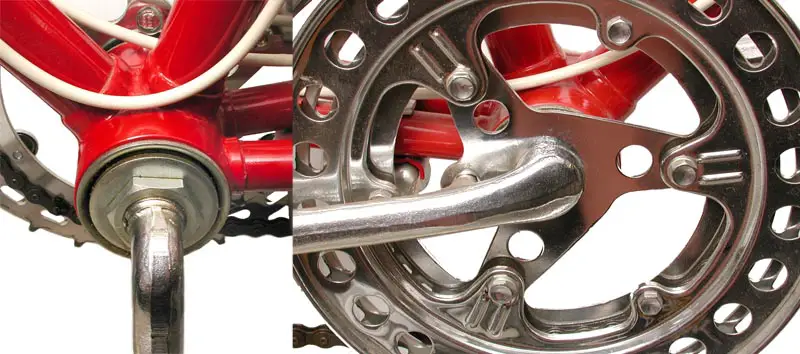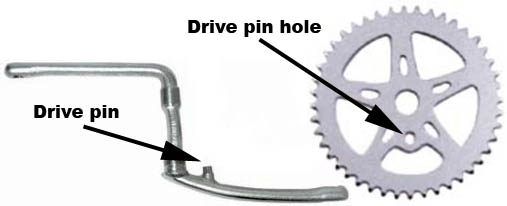One-piece ("Ashtabula") Cranks



One-piece
cranks are mainly found on older American-made bicycles, and children's bicycles made for the U.S. market. Most one-piece cranks use a single metal
forging as left
crank, right crank and
bottom bracket axle.
Bicycle bottom bracket (crank hanger) shells fall, in general, into two groups, threaded and threadless. One-piece cranks fit only the unthreaded shells 51.3 mm (2.02") in diameter.
One-piece cranks are the easiest type to service, and require no special tools. All you need is a large adjustable wrench and a screwdriver.


Disassembly
To disassemble a one-piece crank, start by removing the left pedal (turn it clockwise to unscrew it--everything on the left side of a one-piece crank is left (reverse) threaded.) Then remove the
locknut on the left side bottom bracket (clockwise to remove), lift off the
keyed washer, and unscrew the left
cone (clockwise to remove.) The left cone usually has grooves that allow you to turn it with a flat-bladed screwdriver. Pull out the ball
retainer, then you will be able to withdraw the whole crank assembly from the right side of the bottom bracket. Pull the crank partway out of the bottom bracket, then reach in and remove the right side bearing retainer. If you try to pull the corners of the one-piece crank through without removing both retainers from their cups first, you may damage the retainers.
Clean and inspect the cones, cups and bearing retainers. If they are smooth and free from pitting, you can re-use them. In most bicycle applications, bearings with loose balls are preferable to those that use retainers (cages.) One-piece cranks, along with headsets, are a major exception to this rule. It is extremely difficult to assemble a one-piece crank set with loose balls, I would not recommend trying.
Interchangeability
Pedal threading is unique. One-piece cranks fit pedals with a 1/2" x 20 TPI threading. All other common cranks (except some older French cranks) use a 9/16" x 20 TPI threading. See my glossary entry on pedal threading.
There are two major types of one-piece crank sets, differentiated by their axle threading. The more common size uses 24 threads per inch, but some bikes, particularly older U.S. made Schwinn and Mongoose models, use 28 threads per inch. No part of the bearing assembly is interchangeable between threadings.
24 TPI cranks use #66 retainers, with 10 5/16" balls.
28 TPI cranks use #64 retainers, with 9 5/16" balls.
The pressed-in
cups are also a slightly different size internally, though they both fit the same frame bottom brackets. It is usually a good idea to buy a whole set (cones, cups, retainers) if there is serious wear to any of the parts. These are not expensive. Good sets are less than $20.
It is also possible to buy conversion bearing assemblies that will work with cotterless three-piece cranks. These are often worthwhile if you are trying to upgrade the performance of an older bike.
An even better solution is to get a set of adaptor bushings that permit the use of modern threaded cups and three-piece cranks.
A much wider variety of pedals is available for the pedal threading used on three-piece cranks..
 Chainwheels
Chainwheels
Virtually all one-piece-crank chainwheels are interchangeable. They have a 15/16" hole in the middle, and another, smaller hole for the drive pin of the right crank to engage. You can buy single chainwheels of various sizes, usually for 1/8"
chain, or double or triple chainwheels for 3/32" chain. The doubles and triples are usually riveted together units, with standard ratios. Doubles commonly come in 39/52. Triples are most often 28/38/48, but other combinations are available.
You can also buy a spider or "power disc" that fits onto the one-piece crank as a normal chainwheel does, but which has holes to accept standard 110 mm or 130 mm BCD (Bolt Center Diameter) chainrings. This allows the use of high-quality 3/32" chainrings designed for derailer use. Most "power" discs will work with either the 110 mm or the 130 mm size.


If you would like to make a link or bookmark to this page, the URL is:
https://www.sheldonbrown.com/opc.html
Last Updated: by Harriet Fell



![]()
![]()
 Chainwheels
Chainwheels![]()
![]()